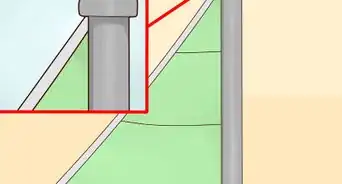X
wikiHow is a “wiki,” similar to Wikipedia, which means that many of our articles are co-written by multiple authors. To create this article, volunteer authors worked to edit and improve it over time.
This article has been viewed 52,774 times.
Learn more...
If you plan on using your boat for duck hunting or just want to give it a little extra pizazz, you can paint it using a camouflage color scheme. The process takes time, but it is not too difficult and can usually be done by hand at a pretty cheap cost.
Steps
Part 1
Part 1 of 2:
Preparing the Boat
-
1Elevate the boat. Position your boat on top of a boat stand so that it is off the ground yet low enough for you to access without much difficulty. Elevating the boat will make it easier for you to work on all sides.[1]
- If you do not have a boat stand to use, you could also use cinder blocks. A boat stand is preferable, though, since cinder blocks will cover a portion of the bottom and prevent you from painting it.
- Keep the boat right side up as you paint it. You will need to paint both the inside and the outside of the boat in order to make the entire thing camouflaged, so you need access to the inside of the boat. By contrast, the bottom of the boat will be hidden under water most of the time, so ducks and similar prey are less likely to see it. You should still camouflage as much of the bottom as you can reach, though.
- If you do not have a boat stand to use, you could also use cinder blocks. A boat stand is preferable, though, since cinder blocks will cover a portion of the bottom and prevent you from painting it.
-
2Sand down the sides. Use a portable electric sander to smooth all the sides of the boat. Start with the inner part of the boat and sand the exterior sides afterward.
- Sanding the boat will remove any old paint or other inconsistencies. As a result, your final painting job will be smoother and neater.
- If you do not have a portable electric sander, you could use a sanding block, instead.
Advertisement - Sanding the boat will remove any old paint or other inconsistencies. As a result, your final painting job will be smoother and neater.
-
3Clean the boat thoroughly. Combine soap and hot water in a large bucket and use the solution to scrub down all sides of the boat. Wash the boat using a hard bristled brush so that you can eliminate more debris in the process.
- As you did while sanding the boat, clean the interior before cleaning the exterior.
- The cleaning solution you use should be very sudsy. For best results, use a soap that is specifically labeled for whatever material your boat is made from. Otherwise, use liquid dish detergent.
- For the best results, you should also consider rinsing down the exterior sides of your washed boat with a water hose that has been fitted with a power sprayer nozzle.
- It is vital that you let the boat dry completely before moving on with primer or paint. You can either towel dry the boat or let it air dry.
- As you did while sanding the boat, clean the interior before cleaning the exterior.
-
4Prime the sides. A good primer will protect the boat and also improve the final look of your boat after you paint it. If you have an aluminum boat, choose a primer with rust proofing. Otherwise, any waterproof primer might be adequate.
- Thin the primer before using it. Doing so can make it easier for the primer to go on and to work its way into the tiny scratches on the side of the boat. As such, your boat will be better protected.
- Thin the primer before using it. Doing so can make it easier for the primer to go on and to work its way into the tiny scratches on the side of the boat. As such, your boat will be better protected.
Advertisement
Part 2
Part 2 of 2:
Painting the Boat
-
1Choose a good stencil. You can purchase large stencils for the side of your boat online or in various stores with hunting and outdoor living products. If you are not sure about where to start, look for stencils of marsh grasses or cattails.
- If you do not want to buy actual stencils, you can create your own by holding actual cattails or swamp grasses up to your boat as you paint it. You could also use skinny pieces of round pipe.
- You could also cut actual stencils out of poster board. Print or sketch the design onto the board and cut out the portions that need o be filled in with your secondary paint.[2]
- Do not use pieces of tape instead of actual stencils or stencil-like elements. Tape will create harsh, sharp lines, and your camouflage will look more out of place as a result. Faded edges are preferable to sharp edges.
- When you attach any type of stencil to your boat, you will need to adhere it on securely with strong tape. Alternatively, you could simply hold up the stencil to the boat side as you spray instead of fixing it in place.
- A marsh grass or cattail pattern is usually the most typical pattern for a boat. On the other hand, you could opt for a more traditional sort of camouflage composed of randomly arranged wavy shapes. The choice is ultimately a matter of personal preference.[3]
- If you do not want to buy actual stencils, you can create your own by holding actual cattails or swamp grasses up to your boat as you paint it. You could also use skinny pieces of round pipe.
-
2Determine your camo color scheme. For practical use, there are only a few color schemes that will actually help camouflage your boat in the water. An earth tone scheme might help, or you could opt for a marine-oriented or navy-oriented palette.
- Earth tone palettes make use of tans, browns, and the occasional deep green.
- Marine and navy oriented palettes blend shades of blue with shades of brown.
- Ultimately, when you choose a color scheme, think about the area you will be using your boat in and try to find three or four colors that will blend in with the surroundings of that area.
- Earth tone palettes make use of tans, browns, and the occasional deep green.
-
3Start with the lightest color. Take the lightest color involved in your pattern and paint the entire boat with one coating of that shade. Allow the paint to dry thoroughly for about 24 hours, and apply a second coat. That coat should also dry for about 24 hours.
- Note that you will not be using a stencil for this portion of the project.
- The surface temperature of the boat should be at least 51 degrees Fahrenheit (10.5 degrees Celsius) when you begin. Avoid painting the boat in temperatures lower than that since cooler temperatures may make it more difficult for the paint to spread and dry.
- Use a paint sprayer instead of a brush or roller in order to achieve the best results.
- It is also important that you start with the lightest color, rather than a darker shade. A light hue will not show up beneath a dark overcoat, but a dark paint will likely show through a light overcoat.
- Note that you will not be using a stencil for this portion of the project.
-
4Progress through the remaining colors. Apply your stencil to the side of the boat and use the darker colors in your camouflage palette to fill in the pattern.
- Work with the light to medium tones first and end with the darkest color you have.
- Choose paints that have a matte, non-reflective finish in water.
- Allow the paint to dry for a full 24 hours.
- For this part of the process, you can either use a paint sprayer or cans of spray paint. Cans of spray paint might be preferable since they will allow you to paint finer lines and details.
- Spray over the stencils in even strokes. The part of the boat covered by your cattails or stencil backing will remain as your lightest color, while the parts that are open will be painted in your secondary colors.
- Mist the color onto the boat by holding the paint can back at a distance. Spray up and down over the stencil with each color to get even coatings.[4]
- Try not to make the pattern look too symmetrical or planned. The lines of your pattern should be somewhat evenly spaced, but they should each tilt at different angles and no set of lines should be spaced apart evenly with another set of lines.
- Work with the light to medium tones first and end with the darkest color you have.
-
5Apply a final clear coat. Use a paint sprayer to coat the entire boat in a single layer of clear, matte or flat paint. This clear coat can protect your paint job from scratches.
- Note that if you choose an oil-based paint, you can also help waterproof your paint job.
- Note that if you choose an oil-based paint, you can also help waterproof your paint job.
Advertisement
Things You'll Need
- Boat
- Boat stand or cinder blocks
- Portable electric sander or sanding block
- Warm water
- Soap
- Large bucket
- Hard bristled brush
- Water hose
- Power sprayer nozzle
- Clean rags
- Rust-proof, waterproof primer
- Primer thinner
- Paint brush or roller
- Paint sprayer
- Oil-based paint in camo colors
- Stencils
- Clear waterproof paint
References
About This Article
Advertisement

























































